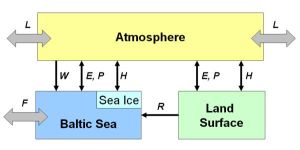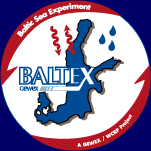Background
Our ability to understand, and to predict weather, climate, and global change depends critically on our capability to measure and model all processes determining the water and energy cycles between and within the components of our climate system. BALTEX, as one GEWEX continental scale experiment, will provide improved understanding of these mechanisms and processes.
BALTEX (the Baltic Sea Experiment) was launched in 1992 as a Continental-scale Experiment (CSE) of the Global Energy and Water Cycle Experiment (GEWEX) within the World Climate Research Program (WCRP). The research focus of BALTEX has primarily been on the hydrological cycle and the exchange of energy between the atmosphere and the surface of the Earth, because they control and regulate the climate in a fundamental manner. The study region of BALTEX is the Baltic Sea and its huge catchment region, which constitutes a unique European water basin, creating specific demands on models and scientific concepts.
The first paragraph of the "Initial Implementation Plan" of 1995 clearly states the scientific goals and main objectives of the first phase of BALTEX:
"BALTEX will explore, model and quantify the various processes determining the space and time variability of the energy and water cycle of the Baltic Sea and its catchment area. BALTEX will undertake specific assessments of the total flux divergence of heat, water and momentum for this region and determine its coupling to the large scale atmospheric circulation and to the water exchange through the Danish Straits. The scientific objectives will be addressed by a combined observational and modelling approach where the Baltic Sea, the land surfaces of its catchment area and the atmosphere will be considered as one system."
The numerous scientific achievements of BALTEX Phase I have called for application in other areas where knowledge on and modelling capabilities of the water and energy cycles in the climate system are fundamental. A Science Plan for BALTEX Phase II has therefore been published in early 2004, which defines 6 major objectives including several specific goals with the overall strategy to enlarge the scientific scope of the programme and to contribute to generating also environmental policy- and stakeholder relevant information.
An important aspect of BALTEX Phase II will be a more holistic approach towards observing, understanding and modelling major environmental and socio-economic aspects relevant for the entire Baltic Sea basin. Parts of the BALTEX Phase II research activities will thus contribute to the build-up of a high resolution integrated modelling capability for Northern Europe, embedded in an Earth System Model.
The "BALTEX Box" illustrates the principal coupling mechanisms between the atmosphere, land and sea including sea ice which have been the research objects of BALTEX:

L = Lateral exchange with the atmosphere outside the BALTEX region
W = Wind stress at the sea surface
E, P = Evaporation and precipitation over land and sea
H = Heat and energy flux at the air-sea and air-land interfaces, including radiation
R = River runoff
F = In- and outflow through the Danish Straits
(From the BALTEX Initial Implementation Plan, 1995)
|

